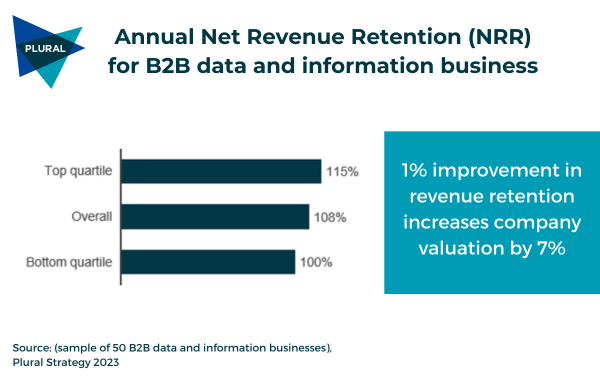It’s all about NRR
Two of the most important measures of value in a subscription-based information services business are how critical the product is to its users and the potential to grow the value to the user through enhancements, extensions and tools and to monetise that additional value.
These measures can be boiled down into one indicator: Net Revenue Retention (NRR). This is perhaps the most important metric that operators and investors in information services businesses should focus on. Based on our research and extensive work across private and public information services businesses, NRR is the most significant driver of enterprise value and revenue growth.
What is a good retention rate?
Top quartile businesses consistently generate Net Revenue Retention (NRR) of over 115%, with 125 – 130% not uncommon in peak years.

Companies with high net retention rates drive more efficient and easier growth by leveraging their existing customer base rather than constantly acquiring new customers. So, it is no surprise that most investors and acquirers heavily scrutinise net revenue retention. In most cases, we find that investors look at the universal NRR but also want to understand Net Revenue Retention at specific customer or product segments and cohorts.
So, how do you improve Net Revenue Retention?
A critical enabler to improving net revenue retention is customer-centricity. Top-quartile data and information businesses set up their organisations to track and serve evolving customer needs and develop the tools available to act on them.
Plural has identified four areas executives should focus on to bring their retention to top-quartile businesses.
1. Targeted value propositions through customer segmentation
High-performers often apply needs-based or persona-based customer segmentation combined with a quantitative view of the available market opportunity. These segments go beyond customer size and industry and typically cover usage levels, criticality, embeddedness, and specific use cases. This segmented market view enables them to align their value propositions (incl. pricing, product functionalities and service levels) to identify upsell, cross-sell opportunities, and optimise pricing.
Example: a leading data provider segmented its customers based on product usage, criticality and purchasing power and developed targeted packages with different functionalities (e.g., product coverage, APIs, modelling tools). Through segmentation, it could identify the customers who obtained the highest return on investment from the product and required the most functionalities. As a result, they were able to offer these customers a higher-value product package, resulting in a ten percentage points increase in Net Revenue Retention within 12 months.
2. Ensure the frontline has dedicated customer success teams
Based on our sample, most B2B information and data businesses have separate teams for account management and business development, with targeted incentives to ensure sales teams remain focused on retaining and growing existing customers. We observed that outperformers further strengthen their organisation with dedicated customer success teams. Customer success teams proactively respond to changes in customer usage and provide ongoing training and education to ensure customers get the most out of products to encourage long-term engagement and loyalty.
Example: a leading real estate data provider sought to improve retention. There was a challenge related to retaining new customers due to often missed handoffs between sales and account management post-sales. The commercial leadership created a dedicated customer success function with primary accountability for customer churn. The team implemented a multi-step customer onboarding programme, resulting in a ten-percentage point uplift in retention within 12 months. In addition, the team created a surveillance model to evaluate a customer’s risk of churn in real-time based on a range of factors, including customer service interactions, user logins and purchasing patterns. The model enabled the team to intervene early and significantly reduce the risk of churn.
3. Focus on metrics
Outperformers empower their sales and marketing teams through an obsession with metrics supported by sales enablement and measurement tools to identify customers with churn risk and the renewal process. The tools make the sales and teams more efficient due to increased automation and more focus on the customers with the potential for customer churn.
4. Focus on ongoing product development through a multi-year product roadmap.
Top-quartile data and information businesses have an exhaustive, multi-year product development roadmap with product introductions and improvements that deliver additional user value (e.g., better, faster, more efficient). New product development can be notoriously difficult, with new product launches frequently not meeting expected adoption or financial impact.
Top performers maximise their chances of successful product development by integrating their in-house product teams with the frontline customer-facing teams. This enables product teams to develop and improve solutions more effectively as they can quickly respond to customer requests, identify changing needs, and focus on a strong ‘product-market’ fit for existing and new products. We recommend that frontline and product teams meet weekly to ensure ongoing customer feedback is incorporated into product development.
Example: a leading Price reporting agency improved Net Revenue Retention by five percentage points by developing high-quality forecasts to meet the growing customer demand. This initiative was underpinned by the sales team realising that finance functions within existing customers were increasingly using the product for vastly different use cases (risk management instead of transacting) and that there was an opportunity for an improved, forward-looking product offering.
Achieving growth by improving retention rates
By focusing on these four areas, executives can bring their retention rates towards top-quartile performers and driving more efficient growth by leveraging their existing customer base than by constantly acquiring new customers.






